Netgear XSM4216F-100EUS Product Data Sheet
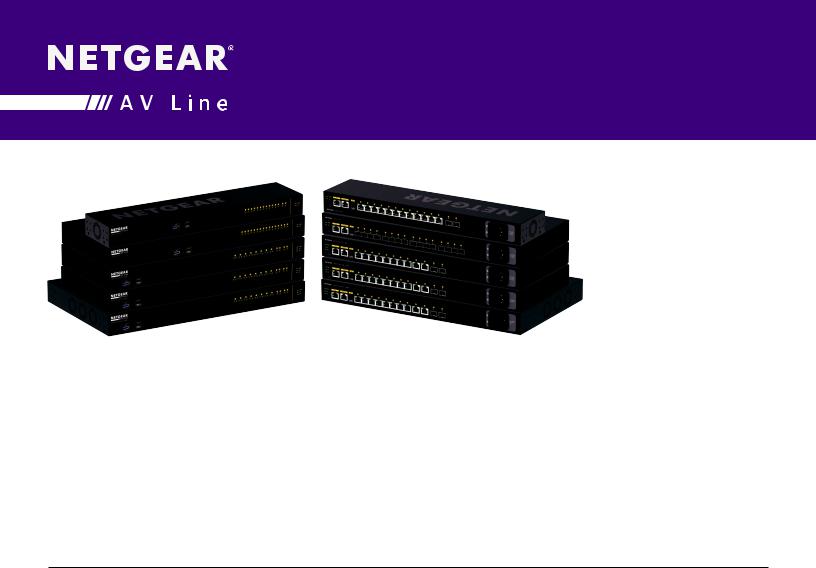
Datasheet | M4250 series
AV Line Managed Switches
Switching
Engineered for AV over IP
The NETGEAR M4250 Switch Series introduces the AV Line, developed and engineered for audio/video professionals with dedicated service and support. M4250 has been built from the ground up for the growing AV over IP market, combining years of networking expertise in AV with M4300 and M4500 series with best practices from leading experts in the professional AV market. AV codecs
generally use 1Gbps or 10Gbps per stream and the AV Line of M4250 targets the widespread 1Gbps codecs.
PoE+, Ultra90 PoE++ and rear-facing ports ensure a clean integration in AV racks. M4250 switches come pre-configured for standard audio and video signals. When requirements are more specific, an AV user interface offers customization with port-based profiles. For audio Dante,
Q-SYS and AES67 profiles are available, as well as an AVB profile requiring an AVB license sold separately. For video the M4250 offers profiles for NVX, SVSI, Q-SYS, NDI, Dante etc. as well as audio/ video/control mixed profiles. When multiple switches, NETGEAR IGMP Plus™ brings automation for you to just connect them together, or with M4300 and M4500 switches.
Highlights
Extended AV features
•DedicatedAVweb-basedGUI interface for more specific AV installations
•Color-basedAVprofilescanbe applied to the different ports
•Dante,Q-SYS,AES67andAVBaudio profiles
•AVBrequiresalicense(soldseparately)
•NVX,SVSI,Q-SYS,NDIandDante video profiles
•Audio/video/controlmixedprofiles
•Automaticswitchinterconnectwith
NETGEAR IGMP PlusTM
•CommonLayer2andLayer3 switching engine across all M4250 models
•Built-inITwebGUI,console,telnet and SSH consistent with other NETGEAR M4300 and M4500 series
•Featuresetincludesstatic,RIPandPIM routing,DHCPServerandPTPv2
Audio Video Bridging (AVB) services
•AVBisoneofthemanyfeatures designed into the M4250 product line
•AVBisanindustrystandardfor transporting content over a network
•AVBisusedmostoftenwhenvery low latency is required such as in live performances when lip sync is critical
•AlloftheAVLineM4250switchescan be optionally licensed for AVB support
Other IT use cases
•Standardorrecessedmountingwithall ports in the back, or all ports in the front
•FullyfeaturedL2/L3/L4platformfor midsize Enterprise campus networks, IoT and IPTV
Industry standard management
•Industrystandardcommandline interface(CLI),mainNETGEARITweb interface(GUI),SNMP,sFlowandRSPAN
•Single-pane-of-glassNMS300 management platform with centralized firmware updates and massconfiguration support
Industry leading warranty
•NETGEARM4250seriesiscovered under NETGEAR ProSAFE Limited Lifetime Hardware Warranty*
•90daysofTechnicalSupportviaphone and email, Lifetime Technical Support through online chat and Lifetime Next Business Day hardware replacement
PAGE 1 of 44
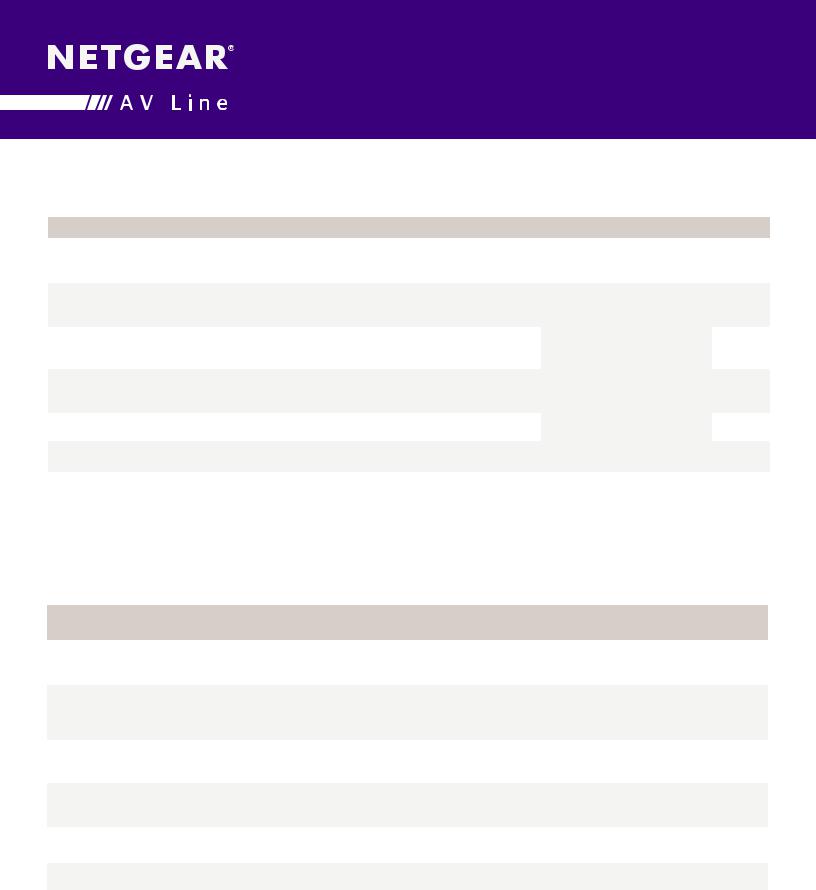
Datasheet | M4250 series
AV Line Managed Switches
Hardware-at-a-Glance
|
|
|
|
REAR (REVERSIBLE)* |
|
|
LEDs |
MANAGEMENT |
|
||
|
|
|
|
|
|
|
|
|
|
|
|
Model |
|
Switching |
10/100/1000 |
100/1000/2.5G |
1000BASE-X |
1000/10G |
|
Status |
Out-of-band |
Model |
|
Form-Factor |
BASE-T RJ45 |
BASE-X |
PSU |
||||||||
Name |
Fabric |
BASE-T RJ45 ports |
SFP ports |
Information |
Console |
Number |
|||||
|
ports |
SFP+ ports |
|
||||||||
|
|
|
|
|
|
|
|
|
|||
|
|
|
|
|
|
|
|
|
|
|
|
|
1U rack mount |
|
8portsPoE+(125W) |
|
2 ports SFP |
|
|
|
Ethernet: |
|
|
M4250-10G2F-PoE+ |
24 Gbps |
2 additional ports |
- |
- |
|
|
GSM4212P |
||||
440 x 43.2 x 200mm |
1G |
|
|
1G Out-of- |
|||||||
|
|
|
|
|
|
|
|
||||
|
|
10M, 100M, 1G |
|
|
|
Available |
band(Rear) |
|
|||
|
|
|
|
|
|
|
|
||||
|
1U rack mount |
|
8portsPoE+(240W) |
|
|
2 ports SFP+ |
Fixed |
both in front |
Console: |
|
|
M4250-10G2XF-PoE+ |
60 Gbps |
2 additional ports |
- |
- |
(C14 |
and in the |
RJ45 RS232 |
GSM4212PX |
|||
|
440 x 43.2 x 200mm |
|
10M, 100M, 1G |
|
|
1G, 10G |
connector) |
rear: |
(Rear) |
|
|
|
|
|
|
|
|
|
|
Console: |
|
||
|
|
|
|
|
|
|
|
|
|
||
|
1U rack mount |
60 Gbps |
8portsPoE++**(720W) |
|
|
2 ports SFP+ |
Power |
Power LED |
USB-C |
|
|
|
|
|
|
(Rear) |
|
||||||
M4250-10G2XF-PoE++ |
2 additional ports |
- |
- |
PoE Max LED |
GSM4212UX |
||||||
|
|
|
switch |
||||||||
440 x 43.2 x 257mm |
|
1G, 10G |
|
||||||||
|
|
|
|
|
Storage: |
|
|||||
|
|
10M, 100M, 1G |
|
|
|
(PoEmodels) |
|
||||
|
|
|
|
|
|
(On/Off) |
|
||||
|
|
|
|
|
|
USB-A |
|
||||
|
|
|
|
|
|
|
|
||||
|
1U rack mount |
|
|
12 ports |
|
2 ports SFP+ |
|
Fan LED |
|
||
M4250-12M2XF |
100 Gbps |
- |
- |
|
(Front) |
MSM4214X |
|||||
|
|
|
|
|
|||||||
440 x 43.2 x 100mm |
100M, 1G, 2.5G |
1G, 10G |
|
Port LEDs |
|
||||||
|
|
|
|
|
LED Ext: |
|
|||||
|
|
|
|
|
|
|
|
|
|
||
M4250-16XF |
1U rack mount |
320 Gbps |
- |
|
- |
16 ports SFP+ |
|
|
USB-C |
XSM4216F |
|
|
|
|
(Front) |
||||||||
440 x 43.2 x 200mm |
|
|
1G, 10G |
|
|
||||||
|
|
|
|
|
|
|
|
|
|||
|
|
|
|
|
|
|
|
|
|
|
|
*Reversed mounting is possible when ports are desired on the front of the rack by using the standard rackmout ears, or the included alternate rackmount ears to mount the switch recessed by 2-Inches to allow for the cabling.
**Ultra90 PoE++ 802.3bt is compatible with 802.3af PoE (15.4W), 802.3at PoE++ (30W) and 802.3bt (60W, 75W and 90W).
Acoustic-at-a-Glance
|
FAN OFF MODE Setting / maximum loading* |
QUIET MODE Setting at 25ºC ambient** |
COOL MODE Setting at 25ºC |
|
|||||||||||
|
ambient** |
|
|
|
|||||||||||
|
|
|
|
|
|
|
|
|
|
|
|
|
|
||
|
|
|
|
|
|
|
|
|
|
|
|
|
|
|
|
Model |
|
|
|
PoE |
|
PoE Power |
Fan |
|
Case |
|
Fan |
|
Case |
|
Model |
Fanless State |
Ambient |
Sensor |
Power |
Conditions |
Sensor |
Temp |
Acoustic |
|
Temp |
Acoustic |
|||||
Name |
|
|
|
Load |
|
Load |
Duty |
|
(Top) |
|
Duty |
|
(Top) |
|
Number |
|
|
|
|
|
|
|
|
|
|
|
|
|
|||
|
|
|
|
|
|
|
|
|
|
|
|
|
|
|
|
|
0dBA/37.1ºC |
|
|
|
All ports |
|
|
|
|
|
|
|
|
|
|
M4250-10G2F-PoE+ |
25ºC |
<=42ºC |
80W |
can be |
125W |
25 |
<=36ºC |
35.9ºC |
27.38dBA |
100 |
|
27.2ºC |
55dBA |
GSM4212P |
|
|
CaseTemp |
|
|
|
used |
|
|
|
|
|
|
|
|
|
|
|
|
|
|
|
|
|
|
|
|
|
|
|
|
|
|
|
|
|
|
|
|
|
|
|
|
|
|
|
|
|
|
|
0dBA/38.4ºC |
|
|
|
All ports |
|
|
|
|
|
|
|
|
|
|
M4250-10G2XF-PoE+ |
25ºC |
<=44ºC |
90W |
can be |
240W |
25 |
<=37ºC |
40.6ºC |
27.4dBA |
100 |
|
30.9ºC |
56dBA |
GSM4212PX |
|
|
CaseTemp |
|
|
|
used |
|
|
|
|
|
|
|
|
|
|
|
|
|
|
|
|
|
|
|
|
|
|
|
|
|
|
|
|
|
|
|
|
|
|
|
|
|
|
|
|
|
|
|
0dBA/42.3ºC |
|
|
|
All ports |
90W |
25 |
<=49ºC |
41.1ºC |
34.57dBA |
|
|
|
|
|
M4250-10G2XF-PoE++ |
25ºC |
<=67ºC |
45W |
can be |
90-180W |
30 |
<=49ºC |
40.8ºC |
40dBA |
100 |
|
41.8ºC |
60dBA |
GSM4212UX |
|
CaseTemp |
|
||||||||||||||
|
|
|
|
|
used |
180W-720W |
40 |
<=49ºC |
52.1ºC |
47.19dBA |
|
|
|
|
|
|
|
|
|
|
|
|
|
|
|
|
|
|
|
|
|
|
0dBA/56ºC |
|
|
|
8 ports |
|
|
|
|
|
|
|
|
|
|
M4250-12M2XF |
25ºC |
<=64ºC |
- |
2.5G |
- |
25 |
<=58ºC |
53.5ºC |
28.5dBA |
100 |
|
33.2ºC |
55dBA |
MSM4214X |
|
CaseTemp |
|
||||||||||||||
|
|
|
|
(noSFP+) |
|
|
|
|
|
|
|
|
|
|
|
|
|
|
|
|
|
|
|
|
|
|
|
|
|
|
|
|
|
|
|
|
|
|
|
|
|
|
|
|
|
|
|
M4250-16XF |
0dBA/36.2ºC |
25ºC |
<=78ºC |
- |
8 ports |
- |
25 |
<=67ºC |
41.6ºC |
27.44dBA |
100 |
|
30.3ºC |
57dBA |
XSM4216F |
|
CaseTemp |
|
|
|
SFP+ |
|
|
|
|
|
|
|
|
|
|
*Software-controlled fan adjustments enable the fans to be turned off when ambient temperature and PoE loads are appropriate for a totally fanless operation.
**dBAvaluesareSPL(SoundPressureLevel)values,testingfollowingtheISO-7779standard.BystanderMode.ChamberTemp25ºCduringtesting.Full,
100%, Data and PoE loaded. Worst case.
PAGE 2 of 44
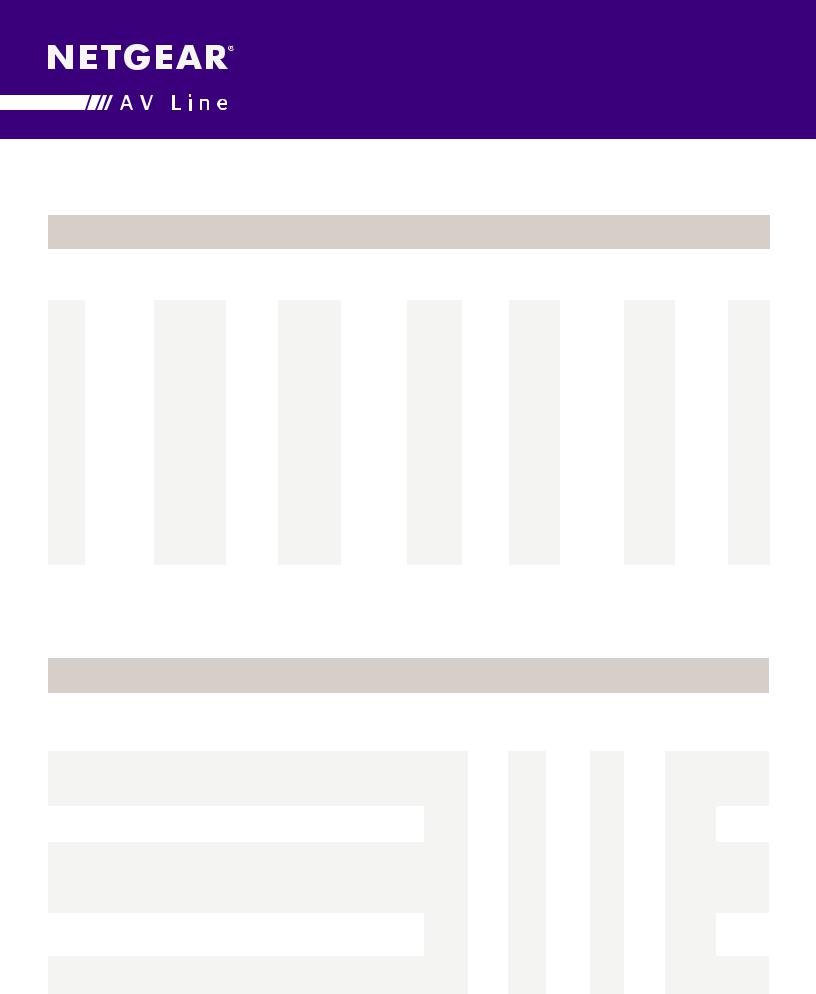
Datasheet | M4250 series
AV Line Managed Switches
Software-at-a-Glance
|
|
|
|
|
LITE LAYER 3 PACKAGE |
|
|
|
|
|
|
||
|
|
|
|
|
|
|
|
|
|
|
|
|
|
|
|
|
IPv4 / IPv6 |
IPv4 / IPv6 |
IPv4 / IPv6 |
Spanning |
|
Trunking |
IPv4 / IPv6 |
IPv4 / IPv6 |
IPv4 / IPv6 |
|
|
Model |
|
AV |
ACLand |
Tree |
|
Model |
|||||||
Management |
Multicast |
Policing and |
VLANs |
Port |
Authentication |
Static |
Dynamic |
||||||
Name |
Dedicated UI |
QoS, |
Green |
Number |
|||||||||
|
Filtering |
Convergence |
|
Channel |
Security |
Routing |
Routing |
||||||
|
|
|
DiffServ |
Ethernet |
|
|
|||||||
|
|
|
|
|
|
|
|
|
|
|
|||
|
|
AV web-based |
|
|
Auto-VoIP |
|
|
|
|
|
|
|
|
|
|
GUI available at |
|
|
|
|
|
|
|
|
|
||
|
|
|
|
|
|
|
|
|
|
|
|
||
|
|
[Switch IP |
|
NETGEAR |
|
|
|
|
|
|
|
|
|
|
|
Address]:8080 |
|
Policy-based |
|
|
|
|
Port, |
|
|
||
|
|
|
IGMPTM Plus |
|
|
|
|
|
|
||||
|
Out-of-band |
|
|
for automated |
routing(PBR) |
STP, MTP, |
Static, |
Static LAG, |
|
Subnet, |
|
|
|
|
|
|
|
IGMP between |
|
Dynamic, |
|
VLAN |
|
|
|||
|
|
Designed for |
|
|
or Dynamic |
|
|
|
|||||
|
|
|
switches |
|
RSTP |
Voice, |
Successive |
routing |
|
|
|||
|
IT Web GUI |
AV installers |
Ingress/ |
LLDP-MED |
LACP |
|
|
||||||
|
|
|
MAC |
Tiering |
|
|
|
||||||
|
(main) |
|
egress |
|
|
|
|
|
|
|
|||
|
|
|
|
|
|
|
|
|
|
||||
|
|
|
|
PV(R)STP |
|
|
(DOT1X;MAB; |
Multicast |
IPv4: RIP |
|
|||
|
|
AV-related |
|
IGMPv3 |
IEEE 1588 |
|
(LACP |
|
|||||
|
|
|
|
|
CaptivePortal) |
static routes |
|
|
|||||
|
|
|
MLDv2 |
|
GVRP/ |
|
|
||||||
|
HTTPs |
controls |
|
PTPv2 |
|
automati- |
|
|
|||||
|
1 Kbps |
|
|
|
|
|
|||||||
M4250 |
Snooping, |
BPDU/STRG |
GMRP |
|
|
IPv4/IPv6: |
All |
||||||
CLI;Telnet;SSH |
|
shaping |
1-Step |
cally reverts |
|
|
|||||||
|
Proxy ASM |
|
DHCP |
|
|
||||||||
series |
|
Audio over IP |
|
End-to-End |
Root Guard |
|
to and from |
DHCPv4 |
PIM-SM |
models |
|||
|
Time-based |
& SSM |
|
||||||||||
|
|
|
Double |
StaticLAG) |
Snooping |
Server |
PIM-DM |
|
|||||
|
|
profiles |
|
|
Transparent |
|
|
||||||
|
SNMP, MIBs |
|
|
|
|
Dynamic ARP |
|
|
|||||
|
|
|
|
Clock |
EEE 802.3az |
VLAN |
|
|
SSM |
|
|||
|
|
|
Single Rate |
IGMPv1,v2 |
|
Inspection |
|
|
|||||
|
RSPAN |
|
mode |
Seven(7) |
DHCPRelay |
|
|||||||
|
AVB profile* |
|
(EEEis |
IP Source |
|
|
|||||||
|
|
Policing |
Querier |
|
|
L2/L3/L4 |
|
|
|
||||
|
|
|
|
(compatiblev3) |
AVB*: |
disabled by |
|
Guard |
|
|
|
||
|
Radius Users, |
|
|
Private |
hashing |
|
|
|
|||||
|
|
|
|
|
default) |
|
Stateful |
|
|
||||
|
Video over IP |
|
|
802.1AS, |
algorithms |
|
|
|
|||||
|
TACACS+ |
|
|
|
VLANs |
|
DHCPv6 |
|
|
||||
|
profiles |
|
ControlPacket |
802.1Qav, |
|
|
|
|
|
||||
|
|
|
|
|
|
|
Server |
|
|
||||
|
|
|
|
802.1Qat MSRP, |
|
|
|
|
|
|
|||
|
|
|
|
Flooding |
|
|
|
|
|
|
|||
|
|
|
|
|
|
|
|
|
|
|
|||
|
|
|
|
802.1ak MMRP, |
|
|
|
|
|
|
|
||
|
|
Mixed Audio and |
|
|
|
|
|
|
|
|
|
||
|
|
|
|
802.1ak MVRP |
|
|
|
|
|
|
|
||
|
|
Video profiles |
|
|
|
|
|
|
|
|
|
||
|
|
|
|
|
|
|
|
|
|
|
|
||
|
|
|
|
|
|
|
|
|
|
|
|
|
|
* Requires AVB license, sold separately. All other software features are available, license-free.
Performance-at-a-Glance
|
|
|
|
|
|
TABLE SIZE |
|
|
|
|
|
|
|
||
|
|
|
|
|
|
|
|
|
|
|
|
|
|
|
|
|
|
|
|
|
|
|
IP |
|
|
Multicast |
|
|
|
|
|
|
MAC |
Routing/ |
|
|
|
|
|
|
IGMP |
|
|
|
|
||
Model |
Throughput |
Application |
Packet |
|
Multicast |
|
Jumbo |
|
|
|
Model |
||||
Switching |
Latency |
CPU |
Group |
VLANs |
DHCP |
sFlow |
|||||||||
|
|||||||||||||||
Name |
ARP/NDP |
Capacity |
64-byte |
Route Scaling |
Buffer |
|
Routing |
|
Frames |
member- |
|
|
|
Number |
|
|
|
|
|
|
|
|
Entries |
|
|
ship |
|
|
|
|
|
|
|
|
|
|
|
|
|
|
|
|
|
|
|
||
M4250-10G2F-PoE+ |
16KMAC |
24 Gbps |
17.86 |
Static: |
16Mb |
<2.27µs 1G |
|
|
|
|
|
|
|
GSM4212P |
|
4K ARP/ |
Line-Rate |
Mpps |
894v4/126v6 |
|
|
|
|
|
|
|
|||||
|
NDP |
RIP: 32v4 |
|
|
|
|
|
|
|
|
|
|
|||
|
|
|
|
|
|
|
|
|
|
|
|
|
|||
|
|
|
|
|
|
|
|
|
|
|
|
|
|
|
|
M4250-10G2XF-PoE+ |
16KMAC |
60 Gbps |
44.64 |
Static: |
16Mb |
<2.14µs 1G |
|
|
|
|
|
|
|
GSM4212PX |
|
4K ARP/ |
Line-Rate |
Mpps |
894v4/126v6 |
<0.84µs 10G |
|
|
|
|
|
DHCP |
|
||||
|
NDP |
RIP: 32v4 |
|
|
|
|
|
|
|
|
|||||
|
|
|
|
|
|
ARM A9 |
|
|
|
Server: |
|
|
|||
|
|
|
|
|
|
|
|
|
|
|
|
|
|||
|
|
|
|
|
|
|
|
|
|
|
|
|
|||
|
|
|
|
|
|
|
|
|
|
|
|
|
|
||
|
|
|
|
|
|
|
|
1.25Ghz |
|
|
|
2K leases |
16 samplers |
|
|
|
16KMAC |
|
|
Static: |
|
|
512 IPv4 |
2GB |
Up to |
2K IPv4 |
4K |
|
|
||
|
60 Gbps |
44.64 |
|
<1.84µs 1G |
|
16 pollers |
|
||||||||
|
|
|
|
|
|
||||||||||
M4250-10G2XF-PoE++ |
4K ARP/ |
Line-Rate |
Mpps |
894v4/126v6 |
16Mb |
<0.81µs 10G |
128 IPv6 |
RAM |
12K |
2K IPv6 |
VLANs |
IPv4: 256 |
8 receivers |
GSM4212UX |
|
|
NDP |
|
|
RIP: 32v4 |
|
|
|
256MB |
|
|
|
pools |
|
||
|
|
|
|
|
|
|
|
|
|
|
|
|
|||
|
|
|
|
|
|
|
|
Flash |
|
|
|
IPv6: 16 |
|
|
|
|
|
|
|
|
|
|
|
|
|
|
|
|
|
||
|
|
|
|
|
|
|
|
|
|
|
|
pools |
|
|
|
M4250-12M2XF |
16KMAC |
100 Gbps |
74.40 |
Static: |
16Mb |
<2.84.µs 1G |
|
|
|
|
|
|
MSM4214X |
||
|
|
|
|
|
|
|
|||||||||
4K ARP/ |
Line-Rate |
Mpps |
894v4/126v6 |
<6.02µs 2.5G |
|
|
|
|
|
|
|
||||
|
NDP |
RIP: 32v4 |
|
<0.81µs 10G |
|
|
|
|
|
|
|
|
|||
|
|
|
|
|
|
|
|
|
|
|
|
||||
|
|
|
|
|
|
|
|
|
|
|
|
|
|
|
|
M4250-16XF |
16KMAC |
320 Gbps |
238.08 |
Static: |
16Mb |
<1.30µs 1G |
|
|
|
|
|
|
|
XSM4216F |
|
4K ARP/ |
Line-Rate |
Mpps |
894v4/126v6 |
<0.86µs 10G |
|
|
|
|
|
|
|
||||
|
NDP |
RIP: 32v4 |
|
|
|
|
|
|
|
|
|
||||
|
|
|
|
|
|
|
|
|
|
|
|
|
|||
|
|
|
|
|
|
|
|
|
|
|
|
|
|
|
|
PAGE 3 of 44
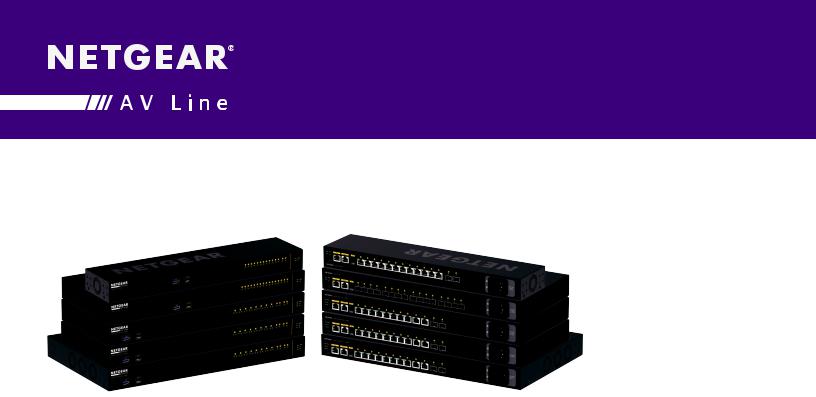
Datasheet | M4250 series
AV Line Managed Switches
Product Brief
The NETGEAR AV Line M4250 series was designed with input from AV Professionals. The result is a line of switches built from the ground up to support 1Gb audio and video over IP with customized hardware and software along with dedicated service and support.
NETGEAR M4250 series key features:
•Rangesfrom8to16portswithavariety of PoE+ and Ultra90 PoE++ options for 15.4W, 30W, 60W, 75W and 90W AVoIP endpoints
•Uplinkoptionsinclude1Gforaudio installations or standalone video installations as well as 10G uplinks for larger scale video deployments
•Alsoincludes12-portmulti-gigabit
Ethernet and 16-port 1G/10G fiber models for plug and play aggregation in a star topology
•Designedforacleanintegrationwith traditional rack-mounted, AV equipment
•TheM4250switchescomewithasleek, black display panel with status in front and all cabling plus additional status in the back
•Reversedmountingispossiblewhen ports are desired on the front of the rack
•Asecondpairofrackmountearsallows the switches to be mounted recessed by 2-inches to allow for the cabling
•Software-controlledfanadjustments enable the fans to be turned off when ambient temperature and PoE loads are appropriate for a totally fanless operation
•Threadedholesonthebottom(4xM5 for50x100mmVESA)andinfront (1xM10forclamps)allowforuniversal mounting options outside the rack as well
NETGEAR M4250 series AV software features:
•Pre-configuredforaudioandvideo over IP out of the box, the M4250 switches enable encoders and decoders to be connected with zero configuration
•Whenmoreconfigurationisrequired, an AV web-based GUI is available at the switch IP address:8080
•Thisinterfacehasbeenspecially designed for AV installers with specific AV-related controls made more accessible and with port-based profiles
•Foraudio,profilesforDante,Q-SYS and AES67 are built-in, as well as an
AVBprofile (AVBlicensesoldseparately)
•Forvideo,theM4250offersprofilesfor
NVX, SVSI, Q-SYS, NDI, Kramer KDS, Aurora Multimedia, ZeeVee, Atlona, Dante and SDVoE
•OtherAVCODECsandmanufactures are supported as well as audio/video/ control mixed profiles
•Tofurthersimplifystardeployments,
NETGEAR IGMP Plus™ brings multicast automation between all M4250 switches, and with M4300/M4500
•Simplyconnecttheswitchestogether and you are done!
NETGEAR M4250 series other software features:
•AllM4250switchessharethesame high-end NETGEAR Layer 2 / Layer 3 switching engine for a consistent experience
•AllswitchesintheM4250serieshave another main, IT web-based GUI for midsize Enterprise campus networks, IoT and IPTV
PAGE 4 of 44
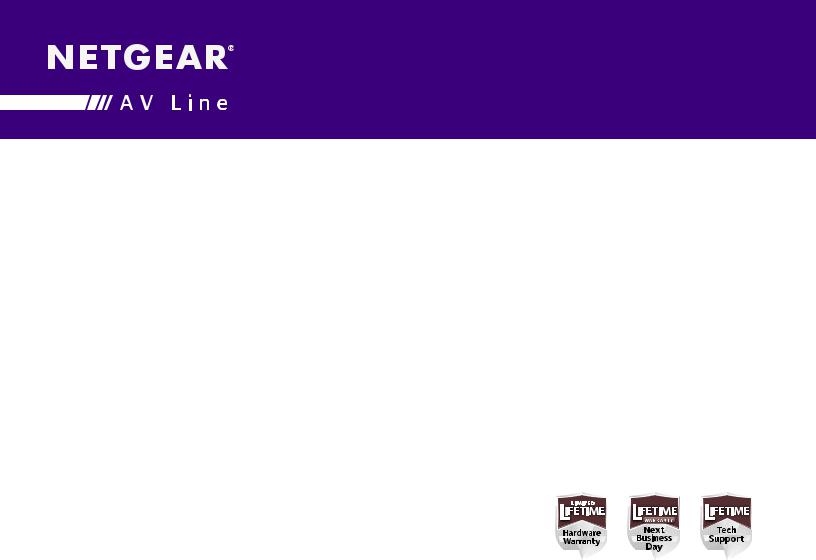
Datasheet | M4250 series
AV Line Managed Switches
•Additionalfeaturesincludestatic,
RIP and PIM-SM, DM and SSM multicast routing,DHCPServerandPTPv2 TransparentClock(1-stepE2E)
•AVBistheonlyfeaturerequiringa license, all other advanced features are available license-free
•Advancedclassifier-based,time-based hardwareimplementationforL2(MAC), L3(IP)andL4(UDP/TCPtransportports) security and prioritization
•SelectablePort-Channel/LAG (802.3ad-802.1AX)L2/L3/L4hashing for fault tolerance and load sharing with any type of Ethernet channeling
•VoiceVLANwithSIP,H323andSCCP protocols detection and LLDP-MED IP phones automatic QoS and VLAN configuration
•Efficientauthenticationtieringwith successiveDOT1X,MABandCaptive
Portal methods for streamlined BYOD
•ComprehensiveIPv4/IPv6staticand dynamic routing including Policy-based routing and 6-to-4 tunneling
•AdvancedIPv4/IPv6security implementation including malicious codedetection,DHCPSnooping,IP
Source Guard protection and DoS attacks mitigation
NETGEAR M4250 series management features:
•DHCP/BootPinnovativeauto-installation including firmware and configuration file upload automation
•IndustrystandardSNMP,RMON,MIB,
LLDP, AAA, sFlow, RSPAN and PTPv2
•Serviceportforout-of-bandEthernet management(OOB)
•StandardRS232straight-throughserial RJ45andUSBType-Cportsforlocal management console
•StandardUSB-Aportforlocalstorage, logs, configuration or image files
•Dualfirmwareimageforupdateswith minimum service interruption
•Single-pane-of-glassNMS300 management platform with mass configuration support
•Industrystandardcommandline interface(CLI)forITadminsusedto other vendors commands
•FullyfunctionalWebconsole(mainGUI) for IT admins who prefer an easy to use graphical interface
•DedicatedAVweb-basedGUIinterface available at [switch IP address:8080] for AV installations
NETGEAR M4250 series warranty and support:
•NETGEARProSAFELimitedLifetime
Hardware Warranty**
•IncludedLifetimeTechnicalSupport
•IncludedLifetimeNextBusinessDay
Hardware Replacement
•Offeringfreenetworkdesignservices and installation support, the NETGEAR Engineering Services Team is ready
to help ensure your 1G deployments with the M4250 AV over IP switches go as smooth as possible. Just drop us an email at ProAVDesign@netgear.com to get started!
PAGE 5 of 44

Datasheet | M4250 series
AV Line Managed Switches
Features highlights
Dedicated AV UI available at http://IPAddress:8080
M4250 switch series is pre-configured for Audio and Video over IP out of the box with a dedicated AV web-based GUI interface for more specific AV installations
•Color-based AV profiles can be applied to the different ports
•Dante, Q-SYS,AES67 and AVB audio profiles (AVB license sold separately)
•NVX, SVSI, Q-SYS, NDI, Kramer KDS, Aurora Multimedia, ZeeVee, Atlona, Dante, etc. video profiles
•Audio / video / control mixed profiles
Best value switching performance:
16K MAC address table, 4K ARP and 4K concurrent VLANs for typical midsize environnements
Low latency at all network speeds, including 10 Gigabit fiber interfaces
Jumbo frames support of up to 12KB accelerating performance with compatible nodes
Ranges from 8 to 16 ports with a variety of PoE+ and Ultra90 PoE++ 802.3bt options for 15.4W, 30W, 60W, 75W and 90W AVoIP (1G) endpoints
Tier 1 availability
Rapid Spanning Tree (RSTP) and Multiple Spanning Tree (MSTP) allow for rapid transitionning of the ports to the Forwarding state and the suppression of Topology Change Notification
NETGEAR PVSTP implementation follows the same rules than other vendor’s Per VLAN STP for strict interoperability
NETGEAR PVRSTP implementation follows the same rules than other vendor’s Per VLAN RSTP for strict interoperability
•Including industry-standard PVST+ interoperability
•PVSTP is similar to the MSTP protocol as defined by IEEE 802.1s, the main difference being PVSTP runs one instance per VLAN
•In other words, each configured VLAN runs an independent instance of PVSTP
•FastUplink feature immediately moves an alternate port with lowest cost to forwarding state when the root port goes down to reduce recovery time
•FastBackbone feature selects new indirect port when an indirect port fails
•Including industry-standard RPVST+ interoperability
•PVRSTP is similar to the RSTP protocol as defined by IEEE 802.1w, the main difference being PVRSTP runs one instance per VLAN
•In other words, each configured VLAN runs an independent instance of PVRSTP
•Each PVRSTP instance elects a root bridge independent of the other
•Hence there are as many Root Bridges in the region as there are VLANs configured
•Per VLAN RSTP has in built support for FastUplink and FastBackbone
PAGE 6 of 44

Datasheet | M4250 series
AV Line Managed Switches
IP address conflict detection performed by embedded DHCP servers prevents accidental IP address duplicates from perturbing the overall network stability
IP Event Dampening reduces the effect of interface flaps on routing protocols: the routing protocols temporarily disable their processing (on the unstable interface) until the interface becomes stable, thereby greatly increasing the overall stability of the network
Ease of deployment
Automatic configuration with DHCP and BootP Auto Install eases large deployments with a scalable configuration files management capability, mapping IP addresses and host names and providing individual configuration files to multiple switches as soon as they are initialized on the network
Both the Switch Serial Number and primary MAC address are reported by a simple "show hardware" command in CLI - facilitating discovery and remote configuration operations
M4300 DHCP L2 Relay agents eliminate the need to have a DHCP server on each physical network or subnet
•DHCP Relay agents process DHCP messages and generate new DHCP messages
•Supports DHCP Relay Option 82 circuit-id and remote-id for VLANs
•DHCP Relay agents are typically IP routing-aware devices and can be referred to as Layer 3 relay agents
Automatic Voice over IP prioritization with Auto-VoIP simplifies most complex multi-vendor IP telephones deployments either based on protocols (SIP, H323 and SCCP) or on OUI bytes (default database and user-based OUIs) in the phone source MAC address; providing the best class of service to VoIP streams (both data and signaling) over other ordinary traffic by classifying traffic, and enabling correct egress queue configuration
An associated Voice VLAN can be easily configured with Auto-VoIP for further traffic isolation
When deployed IP phones are LLDP-MED compliant, the Voice VLAN will use LLDP-MED to pass on the VLAN ID, 802.1P priority and DSCP values to the IP phones, accelerating convergent deployments
Ease of management and granular control
Dual firmware image and dual configuration file for transparent firmware updates / configuration changes with minimum service interruption
Flexible Port-Channel/LAG (802.3ad - 802.1AX) implementation for maximum compatibility, fault tolerance and load sharing with any type of Ethernet channeling from other vendors switch, server or storage devices conforming to IEEE 802.3ad - including static (selectable hashing algorithms) - or to IEEE 802.1AX with dynamic LAGs or port-channel (highly tunable LACP Link Aggregation Control Protocol )
LACP mode automatically reverts to and from Static LAG, useful when the host isn’t LACP anymore, for instance during a factory reset or re-configuration
Unidirectional Link Detection Protocol (UDLD) and Aggressive UDLD detect and avoid unidirectional links automatically, in order to prevent forwarding anomalies in a
Layer 2 communication channel in which a bi-directional link stops passing traffic in one direction
Port names feature allows for descriptive names on all interfaces and better clarity in real word admin daily tasks
SDM (System Data Management, or switch database) templates allow for granular system resources distribution depending on IPv4 or IPv6 applications
•ARP Entries (the maximum number of entries in the IPv4 Address Resolution Protocol ARP cache for routing interfaces)
•IPv4 Unicast Routes (the maximum number of IPv4 unicast forwarding table entries)
•IPv6 NDP Entries (the maximum number of IPv6 Neighbor Discovery Protocol NDP cache entries)
•IPv6 Unicast Routes (the maximum number of IPv6 unicast forwarding table entries)
•ECMP Next Hops (the maximum number of next hops that can be installed in the IPv4 and IPv6 unicast forwarding tables)
•IPv4 Multicast Routes (the maximum number of IPv4 multicast forwarding table entries)
•IPv6 Multicast Routes (the maximum number of IPv6 multicast forwarding table entries)
Loopback interfaces management for routing protocols administration
Private VLANs and local Proxy ARP help reduce broadcast with added security
Management VLAN ID is user selectable for best convenience
Industry-standard VLAN management in the command line interface (CLI) for all common operations such as VLAN creation; VLAN names; VLAN “make static” for dynamically created VLAN by GVRP registration; VLAN trunking; VLAN participation as well as VLAN ID (PVID) and VLAN tagging for one interface, a group of interfaces or all interfaces at once
Simplified VLAN configuration with industry-standard Access Ports for 802.1Q unaware endpoints and Trunk Ports for switch-to-switch links with Native VLAN
System defaults automatically set per-port broadcast, multicast, and unicast storm control for typical, robust protection against DoS attacks and faulty clients which can, with BYOD, often create network and performance issues
IP Telephony administration is simplified with consistent Voice VLAN capabilities per the industry standards and automatic functions associated
PAGE 7 of 44

Datasheet | M4250 series
AV Line Managed Switches
Comprehensive set of “system utilities” and “Clear” commands help troubleshoot connectivity issues and restore various configurations to their factory defaults for maximum admin efficiency: traceroute (to discover the routes that packets actually take when traveling on a hop-by-hop basis and with a synchronous response when initiated from the CLI), clear dynamically learned MAC addresses, counters, IGMP snooping table entries from the Multicast forwarding database etc...
Syslog and Packet Captures can be sent to USB storage for rapid network troubleshooting
Replaceable factory-default configuration file for predictable network reset in distributed branch offices without IT personnel
All major centralized software distribution platforms are supported for central software upgrades and configuration files management (HTTP,TFTP), including in highly secured versions (HTTPS, SFTP, SCP)
Simple Network Time Protocol (SNTP) can be used to synchronize network resources and for adaptation of NTP, and can provide synchronized network timestamp either in broadcast or unicast mode (SNTP client implemented over UDP - port 123)
Embedded RMON (4 groups) and sFlow agents permit external network traffic analysis
Engineered for convergence and AV-over-IP
Audio (Voice over IP) and Video (multicasting) comprehensive switching, filtering, routing and prioritization
Auto-VoIP, Voice VLAN and LLDP-MED support for IP phones QoS and VLAN configuration
IEEE 1588 (section 10 and 11.5) PTPv2 Transparent Clock (TC) End-to-End implementation considering the residence time of PTPv2 packets from ingress to egress
NETGEAR IGMP PlusTM for automatic multicast across a M4250 / M4300 / M4500 L2 network (Spine and Leaf topologies), removing the need for L3 PIM routing
•1-step Transparent Clock mode, using the residence time of the PPTPv2 packet at the egress port level in
Standalone mode, or Stack Master only
•The "Sync & Delay_Req" field of passing/egressing out PTPv2 packets is updated with the residence time in the switch, the other fields in PTPv2 packets ("Announce", "Delay_Resp", "Pdelay_Req" and "Pdelay_Resp") are not updated
•IGMP Plus is pre-configured on default VLAN 1 out of the box
•IGMP Plus can be configured on another VLAN for automatic IGMP across switches on that VLAN (uplinks can make part of that VLAN in trunk mode)
•IGMP Plus allow AV-over-IP devices (TX/Encoders and RX/Decoders) to be connected across multiple switches in a star topology
•The show igmpsnooping group command in CLI and GUI displays the Source and Group IP addresses along with their corresponding MAC addresses that are learnt through IGMP Snooping in a given VLAN on a given interface
IGMP Snooping and Proxy for IPv4, MLD Snooping and Proxy for IPv6, and Querier mode facilitate fast receivers joins and leaves for multicast streams and ensure multicast traffic only reaches interested receivers everywhere in a Layer 2 or a Layer 3 network, including source-specific (SSM) and any-source (ASM) multicast
Multicast VLAN Registration (MVR) uses a dedicated Multicast VLAN to forward multicast streams and avoid duplication for clients in different VLANs
Multicast routing (PIM-SM and PIM-DM, both IPv4 and IPv6) ensure multicast streams can reach receivers in different L3 subnets
PoE power management and schedule enablement for powering on and powering off PoE nodes connected to the switch
AVB is one of the many features designed into the |
• IEEE 802.1BA-2011 Audio Video Bridging (AVB) when an AVB license is properly installed in the switch |
M4250 product line |
(license sold separately) |
|
• IEEE 802.1AS-2011 gPTP, IEEE 802.1Qav-2009 FQTSS, IEEE 802.1Qat-2010 MSRP, IEEE 802.1ak MMRP, IEEE |
|
802.1ak MVRP |
|
• Maximum of 256 AVB streams per switch |
|
• AVB is not supported in LAG (link aggregation groups, or Etherchannel) |
Layer 3 routing package |
|
Static Routes/ECMP Static Routes for IPv4 and IPv6 |
• Static and default routes are configurable with next IP address hops to any given destination |
|
• Permitting additional routes creates several options for the network administrator |
|
• The admin can configure multiple next hops to a given destination, intending for the router to load share |
|
across the next hops |
|
• The admin distinguishes static routes by specifying a route preference value: a lower preference value is a |
|
more preferred static route |
|
• A less preferred static route is used if the more preferred static route is unusable (down link, or next hop |
|
cannot be resolved to a MAC address) |
PAGE 8 of 44

Datasheet | M4250 series
AV Line Managed Switches
Advanced Static Routing functions for administrative traffic control
In order to facilitate VLAN creation and VLAN routing using Web GUI, a VLAN Routing Wizard offers following automated capabilities:
DHCP Relay Agents relay DHCP requests from any routed interface, including VLANs, when DHCP server doesn’t reside on the same IP network or subnet
Router Discovery Protocol is an extension to ICMP and enables hosts to dynamically discover the IP address of routers on local IP subnets
•Static Reject Routes are configurable to control the traffic destined to a particular network so that it is not forwarded through the router
•Such traffic is discarded and the ICMP destination unreachable message is sent back to the source
•Static reject routes can be typically used to prevent routing loops
•Default routes are configurable as a preference option
•Create a VLAN and generate a unique name for VLAN
•Add selected ports to the newly created VLAN and remove selected ports from the default VLAN
•Create a LAG, add selected ports to a LAG, then add this LAG to the newly created VLAN
•Enable tagging on selected ports if the port is in another VLAN
•Disable tagging if a selected port does not exist in another VLAN
•Exclude ports that are not selected from the VLAN
•Enable routing on the VLAN using the IP address and subnet mask entered as logical routing interface
•The agent relays requests from a subnet without a DHCP server to a server or next-hop agent on another subnet
•Unlike a router which switches IP packets transparently, a DHCP relay agent processes DHCP messages and generates new DHCP messages
•Supports DHCP Relay Option 82 circuit-id and remote-id for VLANs
•Multiple Helper IPs feature allows to configure a DHCP relay agent with multiple DHCP server addresses per routing interface and to use different server addresses for client packets arriving on different interfaces on the relay agent server addresses for client packets arriving on different interfaces on the relay agent
•Based on RFC 1256 for IPv4
•Routers periodically send router discovery messages to announce their presence to locally-attached hosts
•The router discovery message advertises one or more IP addresses on the router that hosts can use as their default gateway
•Hosts can send a router solicitation message asking any router that receives the message to immediately send a router advertisement
•Router discovery eliminates the need to manually configure a default gateway on each host
•It enables hosts to switch to a different default gateway if one goes down
Loopback interfaces are available as dynamic, stable IP addresses for other devices on the network, and for routing protocols
Support of Routing Information Protocol (RIPv2) as a distance vector protocol specified in RFC 2453 for
IPv4
•Each route is characterized by the number of gateways, or hops, a packet must traverse to reach its intended destination
•Categorized as an interior gateway protocol, RIP operates within the scope of an autonomous system
IP Multinetting allows to configure more than one IP address on a network interface (other vendors may call it IP Aliasing or Secondary Addressing)
ICMP Throttling feature adds configuration options for the transmission of various types of ICMP messages
The Policy Based Routing feature (PBR) overrides routing decision taken by the router and makes the packet to follow different actions based on a policy
•ICMP Redirects can be used by a malicious sender to perform man-in-the-middle attacks, or divert packets to a malicious monitor, or to cause Denial of Service (DoS) by blackholing the packets
•ICMP Echo Requests and other messages can be used to probe for vulnerable hosts or routers
•Rate limiting ICMP error messages protects the local router and the network from sending a large number of messages that take CPU and bandwidth
•It provides freedom over packet routing/forwarding instead of leaving the control to standard routing protocols based on L3
•For instance, some organizations would like to dictate paths instead of following the paths shown by routing protocols
•Network Managers/Administrators can set up policies such as:
–– My network will not carry traffic from the Engineering department
–– Traffic originating within my network with the following characteristics will take path A, while other traffic will take path B
–– When load sharing needs to be done for the incoming traffic across multiple paths based on packet entities in the incoming traffic
PAGE 9 of 44
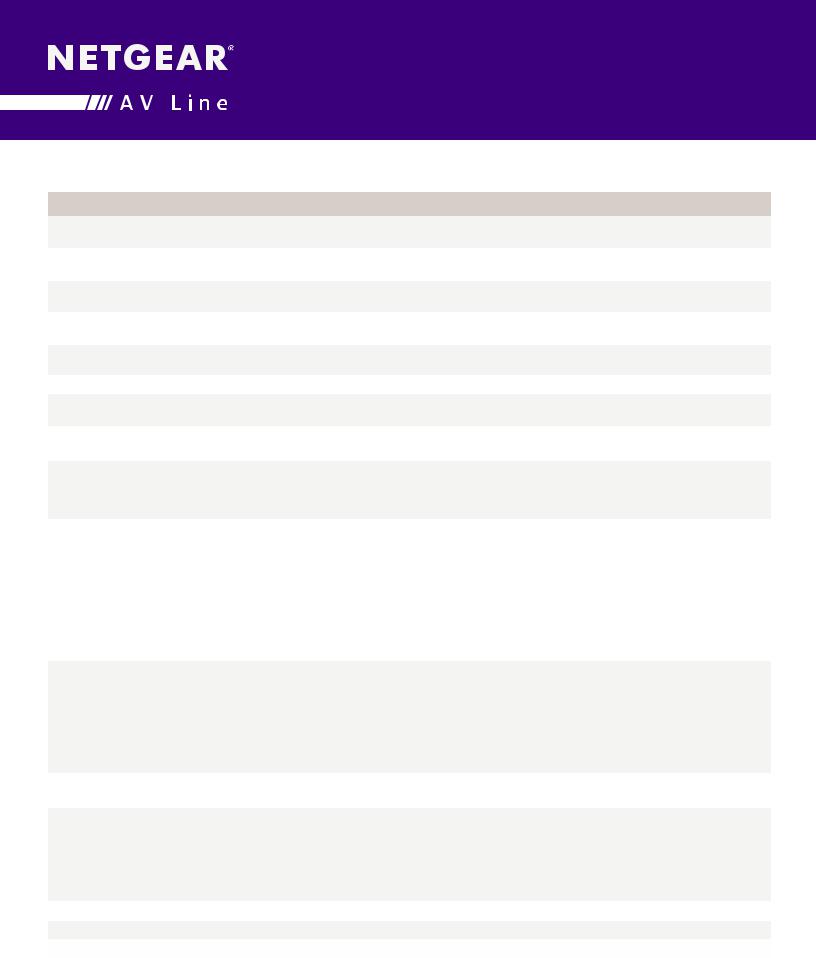
Datasheet | M4250 series
AV Line Managed Switches
Enterprise security
Traffic control MAC Filter and Port Security help restrict the traffic allowed into and out of specified ports or interfaces in the system in order to increase overall security and block MAC address flooding issues
DHCP Snooping monitors DHCP traffic between DHCP clients and DHCP servers to filter harmful DHCP message and builds a bindings database of (MAC address, IP address,VLAN ID, port) tuples that are considered authorized in order to prevent DHCP server spoofing attacks
IP source guard and Dynamic ARP Inspection use the DHCP snooping bindings database per port and per VLAN to drop incoming packets that do not match any binding and to enforce source IP/MAC addresses for malicious users traffic elimination
Time-based Layer 2 / Layer 3-v4 / Layer 3-v6 / Layer 4 Access Control Lists (ACLs) can be binded to ports, Layer 2 interfaces,VLANs and LAGs (Link Aggregation Groups or Port channel) for fast unauthorized data prevention and right granularity
For in-band switch management, management ACLs on CPU interface (Control Plane ACLs) are used to define the IP/MAC or protocol through which management access is allowed for increased HTTP/HTTPS or Telnet/SSH management security
Out-of-band management is available via dedicated service port (1G RJ45 OOB) when in-band management can be prohibited via management ACLs
Bridge protocol data unit (BPDU) Guard allows the network administrator to enforce the Spanning Tree (STP) domain borders and keep the active topology consistent and predictable - unauthorized devices or switches behind the edge ports that have BPDU enabled will not be able to influence the overall STP by creating loops
Spanning Tree Root Guard (STRG) enforces the Layer 2 network topology by preventing rogue root bridges potential issues when for instance, unauthorized or unexpected new equipment in the network may accidentally become a root bridge for a given VLAN
Dynamic 802.1x VLAN assignment mode, including Dynamic VLAN creation mode and Guest VLAN / Unauthenticated VLAN are supported for rigorous user and equipment RADIUS policy server enforcement
802.1x MAC Address Authentication Bypass (MAB) is a supplemental authentication mechanism that lets non-802.1x devices bypass the traditional 802.1x process altogether, letting them authenticate to
the network using their client MAC address as an identifier
With Successive Tiering, the Authentication Manager allows for authentication methods per port for a Tiered Authentication based on configured time-outs
•Up to 48 clients (802.1x) per port are supported, including the authentication of the users domain, in order to facilitate convergent deployments. For instance when IP phones connect PCs on their bridge, IP phones and PCs can authenticate on the same switch port but under different VLAN assignment policies (Voice VLAN versus other Production VLANs)
•A list of authorized MAC addresses of client NICs is maintained on the RADIUS server for MAB purpose
•MAB can be configured on a per-port basis on the switch
•MAB initiates after unsuccessful dot1x authentication process (configurable time out), when clients don’t respond to any of EAPOL packets
•When 802.1X unaware clients try to connect, the switch sends the MAC address of each client to the authentication server
•The RADIUS server checks the MAC address of the client NIC against the list of authorized addresses
•The RADIUS server returns the access policy and VLAN assignment to the switch for each client
•By default, configuration authentication methods are tried in this order: Dot1x, then MAB, then Captive Portal (web authentication)
•With BYOD, such Tiered Authentication is powerful and simple to implement with strict policies
–– For instance, when a client is connecting, M4300 tries to authenticate the user/client using the three methods above, the one after the other
•The admin can restrict the configuration such that no other method is allowed to follow the captive portal method, for instance
Double VLANs (DVLAN) pass traffic from one customer domain to another through the “metro core” in a multi-tenancy environment: customer VLAN IDs are preserved and a service provider VLAN ID is added to the traffic so the traffic can pass the metro core in a simple, secure manner
Private VLANs (with Primary VLAN, Isolated VLAN, Community VLAN, Promiscuous port, Host port, Trunks) provide Layer 2 isolation between ports that share the same broadcast domain, allowing a VLAN broadcast domain to be partitioned into smaller point-to-multipoint subdomains accross switches in the same Layer 2 network
•Private VLANs are useful in DMZ when servers are not supposed to communicate with each other but need to communicate with a router
•They remove the need for more complex port-based VLANs with respective IP interface/subnets and associated L3 routing
•Another Private VLANs typical application are carrier-class deployments when users shouldn’t see, snoop or attack other users’ traffic
SSL version 3 and TLS version 2 ensure Web GUI sessions are secured
Secure Shell (SSH version 2) and SNMPv3 (with or without MD5 or SHA authentication) ensure SNMP and Telnet sessions are secured
2048-bit RSA key pairs, SHA2-256 and SHA2-512 cryptographic hash functions for SSLv3 and SSHv2 are supported on all M4300 models
PAGE 10 of 44
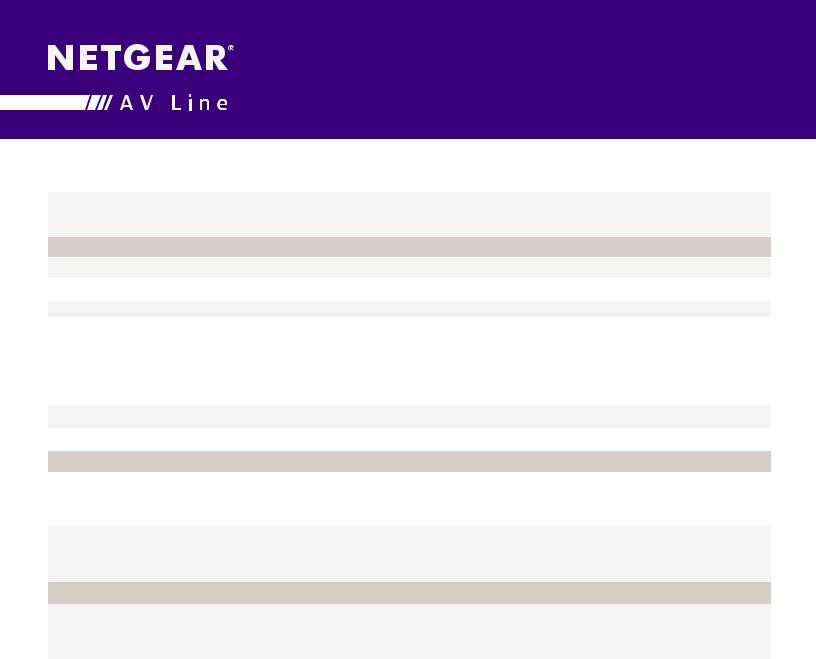
Datasheet | M4250 series
AV Line Managed Switches
TACACS+ and RADIUS enhanced administrator management provides strict “Login” and “Enable” authentication enforcement for the switch configuration, based on latest industry standards: exec authorization using TACACS+ or RADIUS; command authorization using TACACS+ and RADIUS Server; user exec accounting for HTTP and HTTPS using TACACS+ or RADIUS; and authentication based on user domain in addition to user ID and password
Superior quality of service
Advanced classifier-based hardware implementation for Layer 2 (MAC), Layer 3 (IP) and Layer 4 (UDP/TCP transport ports) prioritization
8 queues (7 in a stack) for priorities and various QoS policies based on 802.1p (CoS) and DiffServ can be applied to interfaces and VLANs
Advanced rate limiting down to 1 Kbps granularity and mininum-guaranteed bandwidth can be associated with ACLs for best granularity
Single Rate Policing feature enables support for
Single Rate Policer as defined by RFC 2697
•Committed Information Rate (average allowable rate for the class)
•Committed Burst Size (maximum amount of contiguous packets for the class)
•Excessive Burst Size (additional burst size for the class with credits refill at a slower rate than committed burst size)
•DiffServ feature applied to class maps
Automatic Voice over IP prioritization with protocol-based (SIP, H323 and SCCP ) or OUI-based Auto-VoIP up to 144 simultaneous voice calls
iSCSI Flow Acceleration and automatic protection / QoS with Auto-iSCSI
Flow Control
802.3x Flow Control implementation per IEEE 802.3
Annex 31B specifications with Symmetric flow control, Asymmetric flow control or No flow control
Allows traffic from one device to be throttled for a specified period of time: a device that wishes to inhibit transmission of data frames from another device on the LAN transmits a PAUSE frame
UDLD Support
UDLD implementation detects unidirectional links physical ports (UDLD must be enabled on both sides of the link in order to detect an unidirectional link)
•Asymmetric flow control allows the switch to respond to received PAUSE frames, but the ports cannot generate PAUSE frames
•Symmetric flow control allows the switch to both respond to, and generate MAC control PAUSE frames
•A device that wishes to inhibit transmission of data frames from another device on the LAN transmits a PAUSE frame
•UDLD protocol operates by exchanging packets containing information about neighboring devices
•The purpose is to detect and avoid unidirectional link forwarding anomalies in a Layer 2 communication channel
Both “normal-mode” and “aggressive-mode” are supported for perfect compatibility with other vendors implementations, including port “D-Disable” triggering cases in both modes
PAGE 11 of 44
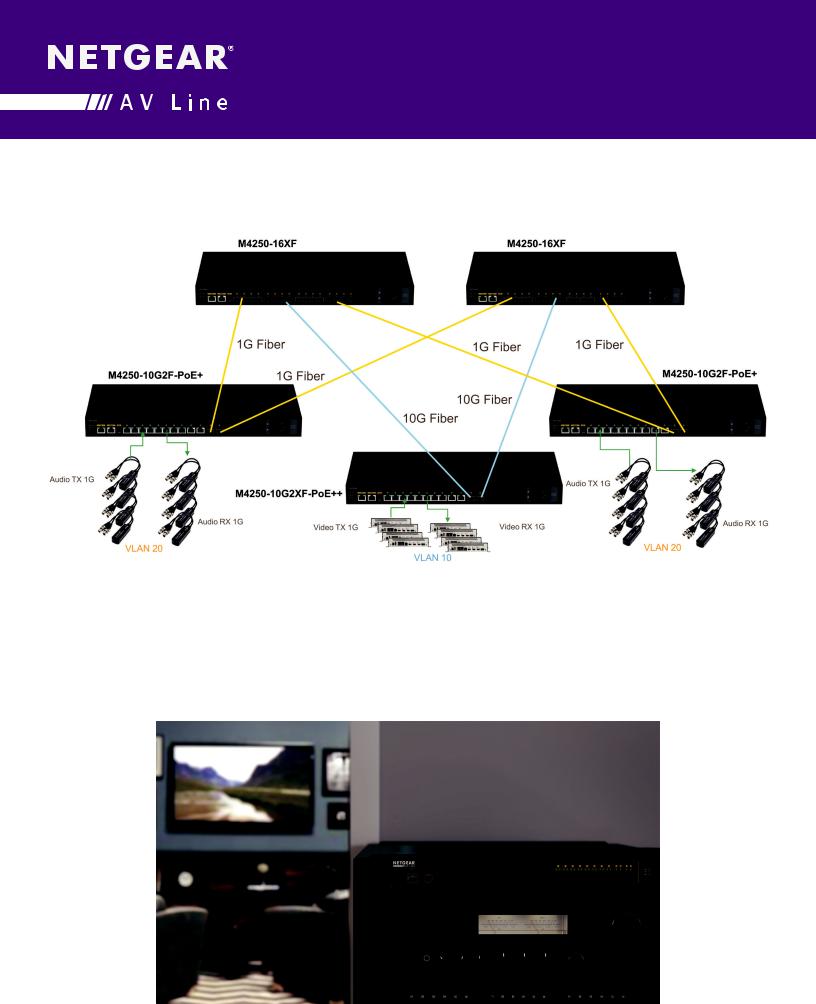
Datasheet | M4250 series
AV Line Managed Switches
Target Application
AnewAVLineof M4250switcheswithout-of-the-boxfunctionalityandanindustry-first:aconcurrentseconduserinterface solely designed with the AV Pro in mind.
NETGEAR has enhanced the experience for AV professionals by including a new user interface designed from the ground up.ProAVcustomers don’t have to settle for an IT-centric interface with settings and IT-specific functionality they will never need. The new M4250 AV interface presents the common AV controls right up front with user-selectable profiles for common AV platforms making it a snap to ensure the settings are correct for a specific audio or video application.
PAGE 12 of 44
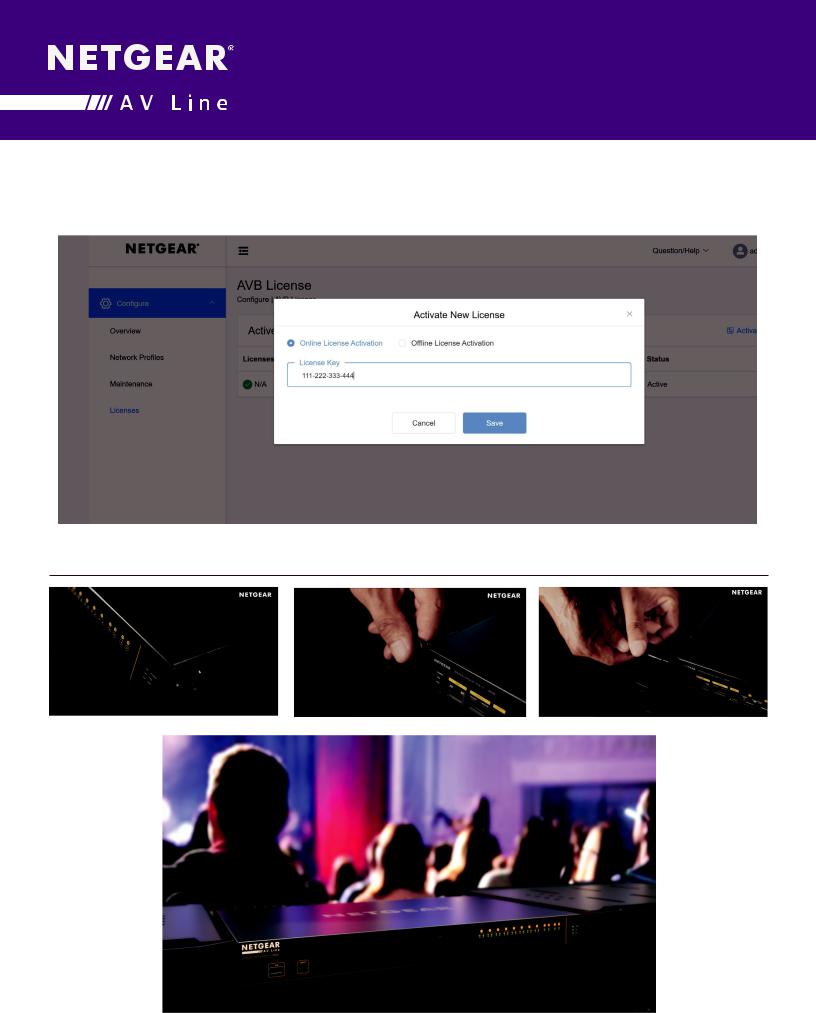
Datasheet | M4250 series
AV Line Managed Switches
Components and Modules
M4250 AV Licenses
M4250 AVB Licenses are electronic SKUs. A license registration key is received by email and can be copied and pasted directly in the AV UI [Switch IP Address:8080] when the switch is online.
PAGE 13 of 44
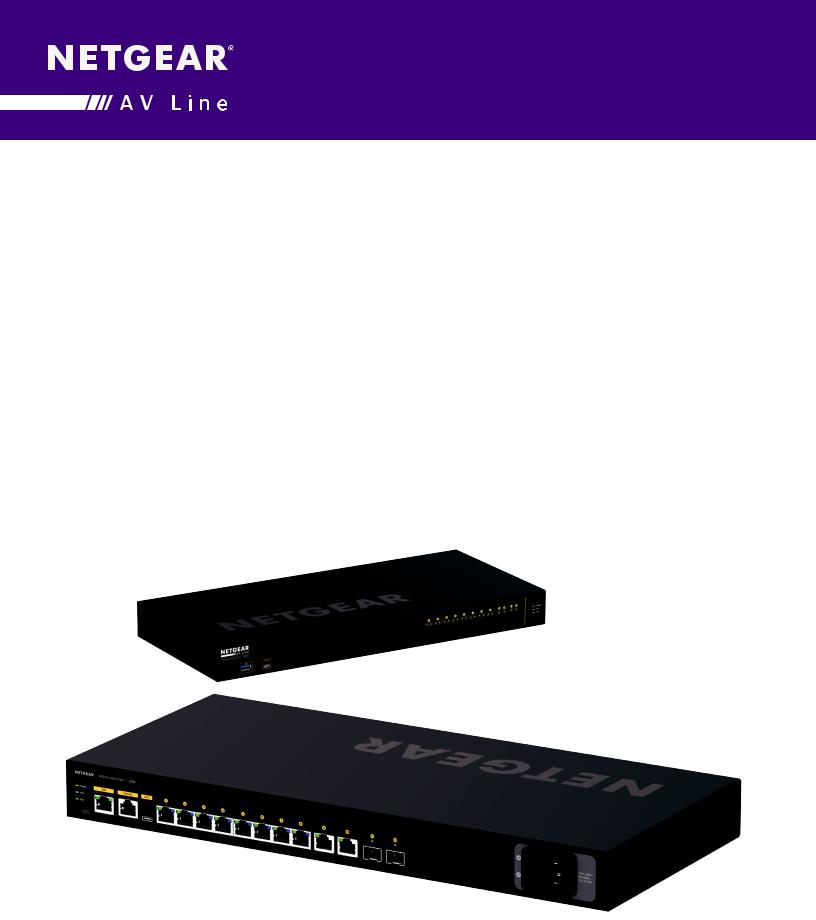
Components and Modules
M4250-10G2F-PoE+
AV Line Managed Switch
Ordering information
•Americas: GSM4212P-100NAS
•Europe: GSM4212P-100EUS
•Asia Pacific: GSM4212P-100AJS
•China: GSM4212P-100PRS
•Warranty: Lifetime ProSAFE Hardware Warranty
•AVB License: AVB4212P-10000S (sold separatel
Datasheet | M4250 series
AV Line Managed Switches
•8-port 10/100/1000BASE-T (RJ45) PoE+ with 125W PoE budget
•2-port 10/100/1000BASE-T (RJ45)
•2-port 1000BASE-X (SFP)
•24 Gbps non-blocking fabric across 12 ports
•Out-of-band 1G Ethernet management port
•USB-C and RJ45 RS232 console ports and USB-A storage port
•Front black display panel and all ports in the back
•Possible reversed mounting with ports in the front
•Rack-mounting standard brackets
•Longer brackets for recessed mounting (2 inches / 5 cm)
•Threaded hole in front (1xM10) for clamps
•Threaded holes on the bottom (4xM5) for 50x100mm VESA plates
•Selectable fan modes for fanless, quiet, or cool operation
•Dimensions (WxDxH): 440 x 200 x 43.2 mm
•Weight: 2.85Kg (6.28lb)
PAGE 14 of 44
